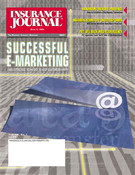In the summer of 2000, a survey on rate and form filings procedures implemented by state insurance departments was sent to the National Association of Independent Insurers (NAII) membership. This survey was conducted in light of efforts being made by Kentucky Insurance Commissioner George Nichols, then president of the National Association of Insurance Commissioners (NAIC), to make state regulation more efficient. NAII member insurers were asked to identify best and worst rate and/or form filing practices for both personal and commercial lines. Respondents were asked to limit these behavioral patterns to a maximum of seven states in each category. While examples of some good and bad traits were provided in the questionnaire, insurers were also asked to cite their own best and worst practices. Survey forms from 96 NAII member companies and groups, representing about 57 percent of the Association’s all-lines premium volume, were returned. (See page 35 for a description of the responding companies.)
An overview of characteristics considered to be best or worst rate and/or form filing practices is provided below:
Best Practices
Most states received votes in the “best practices” area, indicating that insurance departments generally are considered to have at least one favorable trait in their filing process. Overall, respondent companies had more than 900 comments to make for both personal and commercial lines in the different states that they felt displayed these practices most often. It is not surprising that there are more comments relevant to commercial lines than personal lines filings, since the number of participating commercial lines carriers is larger. Table 1 presents distributions of the most commonly mentioned best rate or form filing practices separated between personal lines and commercial lines. Categories are indicated in descending order of favorability for personal lines filings.
Almost every state insurance department that received a “best practices” vote was cited for timely reviews, approvals or acknowledgements.
In the personal lines area, the second most favorable characteristic was department staffs’ friendliness, competence or knowledge, or support in getting companies’ submissions approved. These two practices were mentioned substantially more times by respondents than the next set of best practices, which includes having few forms to complete or file, few layers in the review process, receiving clear instructions, and good communications. Good communications also included the analysts’ ability to explain exactly what the problem is and how to correct it.
“Other” best practices cited, but not as often, were filing exemptions, the lack of fees, equitable treatment, thoroughness in review or record keeping, quarterly or monthly billings, flexibility, and having trust in the company.
In the commercial lines area, the highest ranked “best practices” vote was also timely reviews and approvals, followed by the lack of complex forms to complete and submit.
|
Table 1
Distribution of Best Rate/Form Filing Practices Personal Lines and Commercial Lines |
||
|
Personal
Lines |
Commercial Lines
|
|
| Timely Review/Approval/Acknowledgement |
39.3%
|
41.4%
|
| Friendly/Helpful/Supporting Staff |
21.0%
|
8.7%
|
| Easy or No/Few Forms to Complete of File |
12.9%
|
20.9%
|
| Few Layers/Easy Submission Process |
9.2%
|
8.5%
|
| Clear Instructions |
6.7%
|
10.6%
|
| Good Communications |
4.2%
|
2.9%
|
| Other |
6.7%
|
7.0%
|
| Source: NAII | ||
The relatively large share of comments on form filing exemptions is undoubtedly due to the recent introduction of commercial lines regulatory modernization in a number of states. This category represented 21 percent of total “best-practice” comments on commercial lines, compared to 13 percent on personal lines. Respondent companies also noted clear instructions to be a best practice, followed by supportive department examiners, an easy submission process and good communications. “Other” best practices include those cited above, as well as having reasonable or only a few questions asked, and consistency among analysts and reviews.
Clearly, in dealing with the filing operations, companies regard timely approval by regulators to be the most important characteristic. It is also interesting to note that in spite of there being more commercial lines survey respondents, the number of “best-practice” comments about a friendly, helpful or educated department staff in personal lines was almost double the number in commercial lines. This could be due to the fact that, overall, personal lines filings are more simple to review and process, as the auto and homeowners lines are more straightforward and less intricate and varied than those related to businesses.
Worst Practices
In this survey, the total number of remarks made in the “worst practices” category is about the same as the number of remarks made about best practices. Similar to “best-practice” comments, most states received at least one vote in terms of displaying a poor characteristic. This indicates that while one or more companies may view a state as having positive rate and form filing procedures, at least one other company had the opposite view. And, not surprisingly, there is a greater variety of responses provided for worst rate or form filing practices.
Table 2 sets forth percentage breakdowns of the most commonly mentioned worst rate or form filing practices separated between personal lines and commercial lines. Again, categories are listed in descending order of frequency as they relate to personal lines filings.
As a group, insurers felt that the most common worst filing practice committed by insurance departments is having a review and/or approval process that is too slow. Lengthy approval periods, delays or slow responses were mentioned in 33 percent of the comments on personal lines filings and 24 percent of the comments on commercial lines filings.
Specific comments made with respect to the dilatory timing of reviews or approvals include:
• “Department has taken more than nine months to review filing….”
• “We still have not received approval for filings made over the last several years.”
• “Took almost two years for filing to be approved.”
• “Had to withdraw request after about 10 months’ review time.”
• “They will wait until the last possible day to get reply back; approvals are laborious.”
• “Slow response; when review is initiated, continues until first discrepancy is noted. Filing is returned to company. Review continues after first discrepancy is corrected. Requires multiple handling.”
• “(When) the acknowledgement is sent to the insurer…it really means…that the filing won’t even be assigned to an examiner for at least 30-60 more days.”
• “Have seen examiner use 90 days to the limit many times on one form change; i.e., they request a change….we comply, then it takes another 90 days to review, requests additional changes plus ones originally requested.”
• “60-day review period, begins again with any questions.”
|
Table 2
Distribution of Worst Rate/Form Filing Practices Personal Lines and Commercial Lines |
||
|
Personal Lines
|
Commercial Lines
|
|
| Slow Review/Approval/Acknowledgement |
33.0%
|
24.3%
|
| Inadequate/Inexperienced/Non-supportive Staff/Difficult to Work With |
11.4%
|
9.3%
|
| Numerous/Complicated Forms |
9.4%
|
11.2%
|
| Asks for Too Much Information/Too Many Questions |
7.0%
|
7.6%
|
| Political/Bureaucratic/Local Favoritism |
6.7%
|
4.7%
|
| Burdensome Requirements/Rigid Rules/Multi-Layered Process |
5.7%
|
9.3%
|
| Unwritten Standards |
4.5%
|
2.3%
|
| Excessive Fees |
3.7%
|
3.0%
|
| Confusing/Unclear Instructions |
2.0%
|
4.2%
|
| Other |
16.6%
|
24.1%
|
| Source: NAII | ||
Following very slow reviews and approvals, the next two most commonly mentioned worst practices are: (1) an insurance department staff that is difficult to work with, hard to contact, non-supportive, rude or has an anti-industry attitude (11% of total comments for personal and 9%, commercial); and (2) many complicated forms filings (9%, personal and 11%, commercial).
Apparently, there are still many states that require difficult or excessive form filings in spite of regulatory modernization enacted in some areas. This is supported by a greater portion of comments in the commercial lines area that are related to too much information being requested or too many questions being asked (8%, commercial vs. 7%, personal) and unclear instructions (4%, commercial vs. 2%, personal). The higher figures for commercial lines corroborate the fact that this area is more intricate, therefore resulting in a lack of clarity in explanations, more information and data required, or more questions asked by examiners. Unwritten standards and excessive fees are also two areas that insurers considered negative filing characteristics.
One worst practice that was consistently raised in certain states is political intervention, a consumer advocate office, or local favoritism. Political motivation was mentioned as a worst practice more often as it relates to personal lines filings than to commercial lines filings (7%, personal vs. 5%, commercial).
There is no doubt that an additional office, such as a Consumer Advocate or a Rating Commission, contributes to an extra layer in the review process in some states. Political intervention is often linked to unwritten regulations and standards, too. This negative practice, as it pertains to personal and commercial lines filings, made up about 5 percent and 2 percent of survey responses, respectively.
The larger percentages reflecting both political motivation and unwritten rules for personal lines filings are due to a greater level of sensitivity to rate changes affecting individuals. Where personal insurance rates are concerned, perhaps regulators tend to be more arbitrary in their decision-making.
As mentioned earlier, the objections connected to filings are more varied for commercial lines. This is reflected by the 24 percent share of all negative responses in the commercial lines “Other” category, compared to 17 percent in the personal lines “Other” category. “Other” personal lines worst practices typically include lost filings, being inconsistent, inequitable treatment, negation of the deemer provision, unusual interpretations of the statutes, too many administrative details, being disorganized, a cumbersome microfilm process, the use of Flesch standards, unclear rationale for disapprovals, and not putting things down in writing.
“Other” commercial lines worst practices include these, along with archaic laws, poor actuarial reviews, lockbox filings, difficulties specific to workers’ compensation filings, and the inability to get filings approved (this last worst practice makes up 5% of total comments related to commercial lines).
Examples of worst practices that appeared fairly regularly, but only for certain states, include: (1) exorbitant fees; (2) lockbox filings; (3) too political and favoring local insurers; (4) the existence of a consumer advocate; (5) microfiche requirements; (6) the use of Flesch-scores; and (7) outsourcing of actuarial reviews and charging companies for them.
Respondents were also given the opportunity to elaborate on any best or worst filing practice if they wished.
Listed below are some of these comments:
• “Failure to return calls promptly, if at all, is a major problem in most states. Failure to provide adequate recorded message options when calling main switchboard number is a major problem. When you do reach an operator, you are transferred without any thought to where you are being sent. There is too much reliance on voice mail to answer the phone.”
• “Often, filings sit in the insurance departments for a long period of time because the analyst is not familiar with the product. We would like to encourage the DOIs to call or write immediately with any questions.”
• “States should not make the adoption of ISO’s current loss costs mandatory. It should be up to the company which rate level they choose.”
• “The File & Use and Use & File states (generally) have the best turnaround time, and fewer layers of review.”
• “Filings would get approved much faster if more insurance departments would correspond with companies via fax or e-mail rather than hard-copy mailings.”
• “Any state that allows…adoption of ISO loss costs” is considered a state with a best rating filing practice for commercial lines.
• “States with excessive regulation make it very difficult for small companies to operate. The state thinks they are helping the consumer, but they’re really hurting the consumer by forcing small companies out and reducing competition.”
• “Deregulations are promising.”
• “I would like to see standardized state filing forms. Many states have laborious filing forms that can take hours to complete, and some require information that does not seem relevant to the filing. Standardization of filing forms would make it easier and faster for us to make filings, as well as making the insurance department’s review simpler.”
• “Most states want filers to be able to interpret their laws; it’s hard to know all 50 states. They don’t take into account we are doing other states as well.”
• “It would be very beneficial if insurance departments would invite companies to come in and talk about regulatory requirements and issues in a friendly non-confrontational manner.”
• “We believe a good system is one that promote consumer protection, financial stability, and an insurance-friendly atmosphere.”
|
Description Of Responding Companies
|
Reprinted with permission from the National Association of Independent Insurers Survey of State Insurance Department Rate and Form Filing Procedures, naii.org.
Topics Carriers Legislation
Was this article valuable?
Here are more articles you may enjoy.


 Warburg Mulls $1 Billion Sale of London Insurance Broker McGill
Warburg Mulls $1 Billion Sale of London Insurance Broker McGill  Zurich Makes £7.7 Billion Bid for Specialty Insurer Beazley
Zurich Makes £7.7 Billion Bid for Specialty Insurer Beazley  Allstate Can Proceed With Recovery in Texas RICO Case: Fifth Circuit
Allstate Can Proceed With Recovery in Texas RICO Case: Fifth Circuit  Update: Verizon Says Service Restored After Thousands Affected by Outage
Update: Verizon Says Service Restored After Thousands Affected by Outage 


